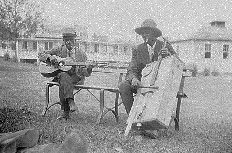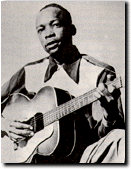|
. .  Roots
of the Blues Roots
of the Blues
B.B.King
In Australia the word ‘blue’ can mean a feeling, an argument, someone with red hair or even a colour.  Photographer
Horydczak, Theodor, ca. 1890-1971
.
The first date we can attach to the blues is 1912,
when several tunes were published that had the word ‘blues’ in the title.
However there is plenty of evidence suggesting that the blues already existed,
and that the writers were now putting on paper what many musicians had
been playing for many years. The orchestra leader W.C.
Handy, whose ‘Memphis Blues’ was one of the songs published in 1912,
described hearing the blues in rural Mississippi well within the first
decade of the twentieth century.
The Africans took an instrument called a banjo to America. However the
guitar became the major instrument used for expressing the blues, as the
tonal qualities were found to be more in keeping with the mood. It is said
that the banjo became associated with the minstrel show stereotype of a
black person and that, with the advent of cheap, mail order guitars, many
blacks switched to the guitar to avoid being associated with the image.
It is no surprise that musicologists claim to have
discovered links between some African music and the blues. The links were
established by observing the use of similar scales, melodic phrasing and
the famous ‘blue’ notes (flattened notes usually the third and seventh
notes of the scale). Today these similarities are best highlighted in the
music of John Lee As rock and roll came to prominence in the fifties, so the blues declined. Many performers moved towards soul, a hybrid of rock and gospel, and towards band oriented orchestrations. Freddy King became one of the most important electric guitarists, influencing rock while staying largely within the blues himself. Chuck Berry, a wonderful songwriter and still popular today, recorded a narrative of teenage culture that resulted in a string of hits, yet many of the reverse sides on the recordings were blues. Blues music was brought to the attention of a much wider audience in the sixties by such bands as the Rolling Stones, Canned Heat, John Mayall’s Bluesbreakers, The Band and many others. These bands also brought back from obscurity many forgotten figures from the past, such as Sun House and Skip James. Some performers did little more than mimic the sound of the originals. Others musicians like Eric Clapton used the blues as a base on which to build their own ideas. There were many performers in the USA, for which the blues was the base for their repertoire. The dreariness of the pop scene in the eighties led to renewed interest
in the blues, largely fuelled by mainstream interest in Robert
Cray. Since then a new breed of blues musicians has arisen
adding elements of rock, gospel and soul, incidentally all derived from
the blues. In recent years there has been enormous growth in white blues,
with a resurgence of bands The blues today is more popular than ever, and has spread to most countries
throughout the world. Despite the growing number of new artists, the biggest
sellers still remain the Chess
stars, such as Muddy Waters, Hound Dog Taylor and
the great J.B. Hutto.
.
About
/ Audio
/ Bands
/ Festivals
/ Gallery
/ Links
|






